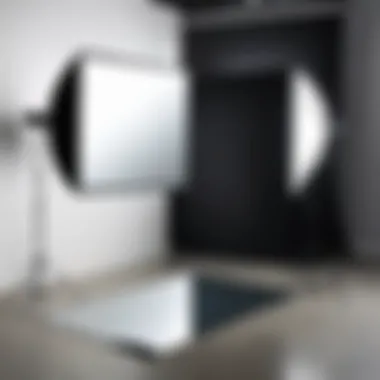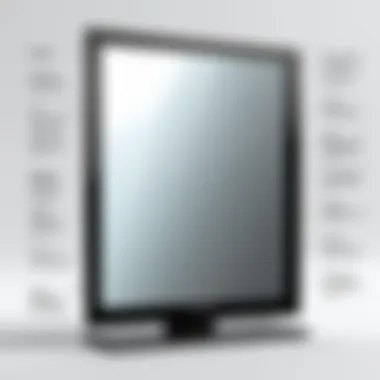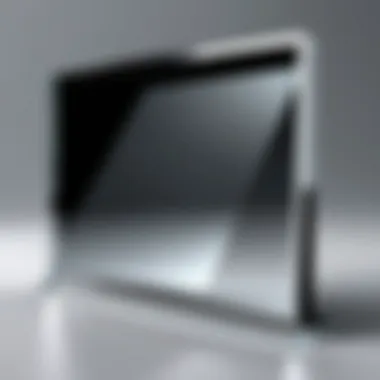Understanding Reflector Screen Mirrors: A Deep Dive


Intro
Reflector screen mirrors represent a unique intersection of technology and practical application. Their function transcends mere reflection; they serve as tools in numerous fields including consumer electronics, photography, and even specialized professional domains. Understanding the core mechanics and significance of these mirrors yields insights into their growing relevance in various industries.
These devices utilize a blend of reflective surfaces and digital display technology to create dynamic interfaces. By reflecting images while also embedding technology, they provide users with enhanced visual experiences. The need for a thorough comprehension of these systems lies not only in their current applications but also in potential future advancements that could further their utility.
An informed understanding of reflector screen mirrors allows IT professionals, software developers, and business leaders to make decisions based on concrete knowledge of these tools. As advancements continue, it’s essential to recognize the features, benefits, and considerations involved in selecting the appropriate reflector screen mirror for specific needs.
Preface to Reflector Screen Mirrors
Reflector screen mirrors have become an essential element in several technological applications. Understanding their importance is critical for professionals in various sectors. This section introduces reflector screen mirrors, elaborating their significance in modern technology, their fundamental purposes, and the benefits they offer to end-users and industries alike.
The term "reflector screen mirror" refers to devices that utilize reflective technology to display images and information from one source to another. With capabilities that vary from enhancing presentations to advancing photography techniques, these mirrors meet a range of needs.
Incorporating reflector screen mirrors in daily operations can improve efficiency, productivity, and clarity in communication. This is especially vital in settings where visual presentations are crucial, such as corporate meetings, classrooms, and video production studios.
By comprehending the different aspects of reflector screen mirrors, professionals can make informed choices about their applications and usages. Through this exploration, readers will find that these mirrors are not merely passive objects; they play an active role in visual experiences and technology adaptation.
Defining Reflector Screen Mirrors
Reflector screen mirrors serve a practical purpose by reflecting images from one point to another. These mirrors can be categorized as optical devices that utilize polished surfaces to redirect light. Specifically, a reflector screen mirror captures and transmits various display outputs, allowing users to view content from computers, tablets, or phones on a larger surface.
The functionality of these mirrors varies based on their designs and materials. For instance, some may offer high-definition reflections, while others are tailored for portability and ease of use. Understanding these distinctions is vital for informed decision-making when selecting a mirror for specific needs.
Historical Development
The evolution of reflector screen mirrors reflects broader trends in technology and media consumption. Early forms of reflective technology can be traced back to ancient civilizations that utilized polished surfaces for personal grooming and ceremonial purposes. However, the modern application of reflector screen mirrors began with the advent of electronic displays.
In the late 20th century, as multimedia technology advanced, reflector screen mirrors transitioned into prominent features in business and education sectors. The development of projection technology created opportunities for enhanced user engagement, transitioning from traditional screens to mirrors that could deliver brighter and clearer images.
Today’s reflector screen mirrors often combine emerging technologies with user-focused design, offering features such as built-in connectivity, adjustable angles, and lightweight frameworks. Such innovations highlight the ongoing relevance and importance of this technology across various domains.
How Reflector Screen Mirrors Work
Understanding how reflector screen mirrors operate is essential for appreciating their functionalities and applications. These mirrors do not merely reflect light; they are meticulously engineered to optimize the projection of images and colors. This section will delve into the science of reflection and the specific materials that contribute to the effectiveness of these devices. The benefits of knowing how reflector screen mirrors function can influence purchasing decisions and improve user experience in various applications.
The Science of Reflection
The principle of reflection is at the core of how reflector screen mirrors operate. When light strikes a reflective surface, it bounces back at an angle equal to the angle at which it hit the surface. This phenomenon is known as the law of reflection. For reflector screen mirrors, this aspect is vital for enhancing visual clarity and minimizing distortion during image projection.
Reflector screen mirrors are designed to provide a smooth reflective surface. The smoothness of the surface directly impacts how well the mirror can reflect light without scattering it. Premium mirrors often use glass or polished plastic, ensuring that images projected onto them maintain integrity in their colors and details. By understanding the dynamics of light reflection, users can better appreciate how these mirrors enhance experiences in settings like home theaters, conference rooms, and photography studios.
"The effectiveness of a reflector screen mirror is determined largely by its surface texture and material, impacting clarity and color fidelity."
Material Composition
The effectiveness of a reflector screen mirror heavily relies on its material composition. Different materials exhibit varying reflective properties, which can substantially alter performance. Common materials include:
- Glass: Often used for its superior reflective quality and durability. It tends to offer the best clarity, making it suitable for high-end applications.
- Acrylic: Lighter than glass and less prone to breakage, acrylic also serves as a good alternative. However, it may show more distortion and is less durable than glass, particularly in demanding environments.
- Metalized Films: Some mirrors utilize specialized films that are coated with metals like aluminum or silver. These films can enhance light reflection while also being lightweight and portable, making them ideal for mobile setups.


Selecting the right material is crucial for achieving the desired quality in image reproduction. Not only does material choice affect durability, but it also determines the mirror's usability across varied contexts—from casual home viewing to professional settings.
Applications of Reflector Screen Mirrors
Reflector screen mirrors play a significant role in various sectors, serving essential functions for both personal and professional use. Understanding these applications helps users appreciate the versatility and importance of this technology. In consumer electronics, photography, and industrial settings, these mirrors enhance performance and deliver unique advantages. Below, we explore the specific uses in these domains while elaborating on the benefits they offer.
In Consumer Electronics
In consumer electronics, reflector screen mirrors primarily function to improve the viewing experience. Devices such as televisions, monitors, or projectors often utilize these mirrors to optimize screen reflections and brightness. The reflective properties help in reducing glare while enhancing picture quality.
Key Benefits Include:
- Enhanced Visual Clarity: The mirrors amplify color saturation and contrast, making images more vivid.
- Reduced Eye Strain: They minimize glare from direct light sources, making it comfortable for prolonged viewing.
- Versatility in Design: Many portable devices benefit from compact mirror designs that don't compromise usability.
These aspects make reflector screen mirrors vital in the consumer electronics market, catering to a demand for improved home and office entertainment systems.
In Photography and Videography
Reflector screen mirrors find substantial applications in photography and videography. They are instrumental in directing light or creating composite images. Photographers often use portable reflectors for capturing subjects under various lighting conditions.
Key Uses Include:
- Light Manipulation: They help in directing natural light, effectively brightening shadowed areas without using additional lighting.
- Image Quality Improvement: Reflectors can enhance features in portraits, allowing better detail definition and color balance.
- Cost-Effective Solutions: Using reflectors reduces the need for extensive lighting setups, which can be expensive and cumbersome.
By integrating reflector screen mirrors in their workflows, professionals can achieve high-quality output without significant additional costs, unlocking creative potential in their projects.
In Industrial Uses
In industrial contexts, reflector screen mirrors are used in various applications, including quality control processes and inspections. They offer precise angles for measuring light intensity, guiding operations and ensuring equipment is functioning optimally.
Considerations in Industrial Applications:
- Durability Requirements: Industrial reflectors must withstand harsh environments and excessive wear.
- Accuracy in Measurements: These mirrors must provide consistent reflections to ensure accurate readings.
- Safety Considerations: Specialized materials may be employed to enhance performance while ensuring user safety.
These advantages make reflector screen mirrors invaluable in ensuring efficiency and reliability in industrial operations, supporting productivity and precision.
The broad usage of reflector screen mirrors across industries highlights their adaptability and critical role in enhancing performance.
Choosing the Right Reflector Screen Mirror
Selecting an appropriate reflector screen mirror is an integral part of ensuring optimal performance for various applications. The right choice will enhance not only usability but also improve the overall experience in technology integration, photography, and other professional uses. Understanding essential factors such as size, reflective quality, and durability can significantly impact selection.
Key Considerations
Size and Portability
Size and portability are fundamental when choosing a reflector screen mirror. A mirror that is easy to transport provides greater flexibility, especially for professionals on the go. Larger mirrors can offer a wider reflective surface, which is beneficial in settings where multiple viewers may need to see the display clearly. However, larger size might compromise portability, making it cumbersome for travel.
The key characteristic of size is its relation to the intended use. If a user requires a mirror for a fixed setup, a larger model may enhance viewing quality. Conversely, for outdoor photography or business presentations, a lightweight and portable option is more advantageous. Hence, it is crucial to strike a balance between size and functionality based on the specific needs of the user.
Reflective Quality


Reflective quality plays a significant role in the effectiveness of a reflector screen mirror. A high reflective quality ensures accurate color reproduction and clarity, making it critical for both photography and professional presentations. Poor reflective quality can lead to distortions that affect the user's experience and undermines the intended purpose of the mirror.
The unique feature here is the material used in the reflective surface. Mirrors made with specialized reflective coatings tend to perform better than standard glass. This higher quality can come at a premium, but it often pays off in enhanced performance. Users need to evaluate how much clarity and color accuracy matter for their applications when considering reflective quality.
Durability
Durability is a core aspect of any product, including reflector screen mirrors. A durable mirror withstands wear and tear, ensuring longevity in various environments. For instance, professionals who frequently use their mirrors in challenging settings will need products that resist scratches and damage.
The key characteristic of durability is the materials used in construction. Mirrors made from robust materials are often more resistant to physical stress. While these may be heavier and less portable, they offer peace of mind regarding long-term use. When selecting a mirror, assessing the conditions in which it will be used helps in weighing the importance of durability versus other factors.
Comparison of Leading Brands
When assessing different models of reflector screen mirrors, it is beneficial to compare leading brands in the market. Each brand offers a unique set of features, such as different sizes, reflective quality, and durability levels. For example, brands like Neewer and Adorama provide a range of options suitable for both amateur photographers and professional users.
In addition to comparing specifications, reading user reviews can also offer insights into performance in real-world settings. This feedback is essential to gauge how well different models can meet user needs. Each brand may have distinctive strengths; understanding these will guide informed decisions during the selection process.
Installation and Maintenance
Reflector screen mirrors serve critical functions in various applications, making their installation and maintenance crucial for optimal performance. Proper installation ensures accurate reflection and minimal distortion. Neglecting maintenance may lead to degradation, affecting usability over time. Thus, understanding these processes is essential for achieving the best results in both personal and professional settings.
Installation Process
Installing a reflector screen mirror involves several steps that require careful attention to detail. The first step is selecting an appropriate location. Ensure that the chosen area is free from obstructions and allows for ideal light conditions, especially if the mirror will be used for photography or videography.
After choosing the location:
- Gather Tools and Materials: You will need a level, measuring tape, drill, screws, and wall anchors. Ensure everything is ready to avoid interruptions during installation.
- Measuring: Use the measuring tape to determine the correct height and position for the mirror. The optimal height typically depends on the user's average eye level.
- Marking: After measuring, mark the drill points on the wall where the screws will go.
- Drilling: Carefully drill holes at the marked points. Ensure the holes are aligned properly to avoid uneven installation.
- Mounting: Secure the mirror using the screws and wall anchors. Double-check that it is appropriately leveled before fully tightening the screws.
- Testing Reflection: Finally, test the mirror by checking the reflection. Make adjustments if necessary to ensure it meets your expectations.
Routine Maintenance Practices
Routine maintenance of reflector screen mirrors is vital for their longevity and functionality. Here are some practices to consider:
- Regular Cleaning: Dust and smudges can accumulate on the surface, compromising reflective quality. Use a soft, non-abrasive cloth and a suitable glass cleaner to wipe the mirror periodically.
- Inspection for Damage: Regularly inspect the mirror for scratches or cracks. Identify any signs of wear to prevent further damage, which may require professional repairs.
- Avoiding Extreme Conditions: Ensure that the mirror is kept away from extreme temperatures or humidity, which can affect its structure and reflective properties.
- Secure Mounting Checks: Periodically check the installation to ensure that screws remain tight and that no shifting occurs, especially in high-traffic areas.
Proper installation and maintenance practices can greatly extend the life of your reflector screen mirror, enhancing performance in its various applications.
By adhering to these guidelines, users can maintain the efficiency and clarity of their reflector screen mirrors, ensuring a continued high-quality performance.
User Feedback and Experiences
User feedback and experiences provide integral insights into the practical applications of reflector screen mirrors. Understanding what users think about their products enables potential buyers to make informed decisions. This section explores the methods of gathering user insights and the processes of analyzing reviews, adding necessary depth to discussions on reflector screen mirrors.
Gathering User Insights
User insights can be sourced through various channels, including online forums, feedback forms, and product review sites. Many platforms, such as Reddit and social media, offer discussion spaces where users can share their experiences with reflector screen mirrors.
Survey tools can also be effective in reaching target audiences. Directly asking specific questions about users' experiences helps gather detailed feedback. For example, asking how well a reflector screen mirror enhances their overall productivity or what features they value most can lead to vital information.
When compiling user insights, it is helpful to categorize feedback into themes. Common themes may include usability, reflective quality, and visual clarity. By quantifying responses, trends can be identified. Analyzing these trends assists in forming a more comprehensive understanding of how reflector screen mirrors perform in real-world scenarios.


Analyzing Reviews
Analyzing reviews requires a systematic approach. Reviews on e-commerce websites, technology forums, or specialized review platforms offer a wealth of information. Analyzing both positive and negative reviews can highlight valuable information.
- Identify Recurring Points: Look for repeated mentions of particular features. If multiple users note that a specific model is particularly durable, it may indicate significant performance.
- Consider the Source: Not all reviews carry the same weight. Reviews from verified purchases or reputable sources are generally more reliable than anonymous posts.
- Weight Positive vs. Negative Feedback: A balanced view includes weighing both types of feedback. Understanding common complaints can also help consumers recognize potential drawbacks before investing.
- Focus on Detailed Feedback: Reviews that provide specific examples tend to be more insightful than low-effort ones. Users explaining how a reflector screen mirror has enhanced their ability to conduct virtual presentations, for instance, give context to the product's effectiveness.
"Taking the time to read through user reviews can save you both time and money. You can discover not only the strengths of a product but also its limitations, leading to better purchase decisions."
In summary, user feedback and experiences serve as a valuable resource for current and potential buyers. These insights can significantly influence decisions, making it pertinent for anyone considering reflector screen mirrors to engage with existing user experiences.
Future Trends in Reflector Screen Technology
Understanding future trends in reflector screen technology is crucial for various stakeholders, including IT professionals and business leaders. This section outlines how innovation influences the capabilities, usability, and market dynamics of reflector screen mirrors. Keeping an eye on these developments enables informed decision-making in selecting the best technology, ensuring organizations remain competitive in their respective fields.
Technological Advancements
Reflector screen technology continuously evolves, driven by several advancements. These innovations primarily focus on enhancing performance, user experience, and adaptability to different environments.
Some notable advancements include:
- Improved Reflective Coatings: New materials are being developed that promise higher reflection percentages. Such enhancements can lead to better performance in diverse lighting conditions, which is particularly important for applications in professional settings.
- Higher Resolution: As display quality improves, the demand for reflector screens that can match resolution output increases. Advances in technology allow for higher pixel counts, ensuring that images reflected maintain clarity and detail.
- Smart Features: Integration of smart technology, such as wireless connectivity and compatibility with various devices, expands the functionality of reflector screens. This includes remote control features and automatic calibration that adjust reflection quality based on ambient light.
- Eco-Friendly Materials: A shift towards sustainable manufacturing practices is noticeable. Companies are seeking materials that not only improve performance but also reduce the environmental impact.
These advancements imply that users of reflector screen mirrors can expect enhanced visual experiences in the years to come.
Emerging Markets and Opportunities
Alongside technological advancements, emerging markets and new opportunities are redefining the landscape of reflector screen mirrors. Identifying these markets is essential for businesses looking to capitalize on trends.
Opportunities include:
- Educational Sector: As remote learning continues to rise, schools and universities increasingly adopt reflector screens for online classes and presentations. The demand for versatile screens that facilitate interactive learning environments grows.
- Corporate Usage: Many businesses are investing in high-quality reflective surfaces for presentations and team meetings. As remote and hybrid work environments thrive, the need for effective communication tools is on the rise, positioning reflector screens as an integral part of office setups.
- Home Automation: Home automation is a growing market, and reflector screens that integrate with smart home devices represent a significant opportunity. Consumers look for solutions that combine functionality with aesthetics.
- Healthcare: Reflector screens that can be used in medical settings for training or patient interaction are becoming increasingly popular. The healthcare industry is discovering innovative ways to utilize reflective technology for better patient outcomes.
"Emerging markets for reflector screen technology suggest a shift towards integrated solutions that address both professional and consumer needs."
Recognizing these emerging trends requires not just an understanding of technology but also a vision for future applications, ensuring businesses can adapt to meet changing demands.
The End
The conclusion of this article encapsulates the critical aspects of reflector screen mirrors, synthesizing the information presented throughout all sections. This topic holds significant relevance in various spheres such as consumer electronics and professional fields like photography and videography. Understanding the nuances of reflector screen mirrors not only enhances the practical applications of this technology but also informs better purchasing decisions.
Summary of Key Points
Reflector screen mirrors function on basic principles of reflection, utilizing specially designed materials. Their main applications span consumer electronics such as smart TVs and projectors, while also being pivotal in areas like photography and specialized industrial needs. Key considerations when choosing a reflector screen mirror include:
- Size and Portability: Depending on the usage context, the size could heavily impact convenience.
- Reflective Quality: A crucial element that directly affects visual output.
- Durability: Essential for longevity, especially in demanding environments.
Both installation and maintenance practices are fundamental for optimal performance. Gathering user feedback and insights into experiences enriches the analysis and adds value to future advancements in the technology. As industries continue to evolve, the prospects for reflector screen mirrors will likely expand into emerging markets, opening new opportunities.
Final Thoughts on Reflector Screen Mirrors
Reflector screen mirrors are not merely passive objects; they play a vital role in enhancing visual experiences in everyday technology. As advancements in materials and designs emerge, it's important for users to stay informed on the latest trends. Investing in the right reflector screen mirror based on informed choices can not only result in improved satisfaction but can significantly impact professional outcomes in fields requiring high visual fidelity.
As technology progresses, integrating feedback and insights from users will continually shape the market. Thus, understanding reflector screen mirrors might be more valuable than ever for professionals aiming for excellence in their respective fields.
"Understanding the underlying technology and potential future trends equips users with a stronger foundation for making educated decisions in their pursuits."
For further exploration of technology trends related to reflector screens, check resources such as Wikipedia, Britannica, and community discussions on platforms like Reddit or Facebook.



